Review of Next-Generation Wireless Devices with Self-Energy Harvesting for Sustainability Improvement
Abstract
1. Introduction
1.1. Healthcare
1.2. Retail
1.3. Logistic and Transportation
1.4. Manufacturing or Industrial Sector
1.5. Education
1.6. Hospitality
1.7. Agriculture
2. Significance of Energy Harvesting for Wireless Devices
2.1. Sustainability
2.2. Extended Battery Life
2.3. Mobility
2.4. Scalability and Flexibility
2.5. Reliability and Redundancy
2.6. Environmental Impact
2.7. Cost Efficiency
3. Limitations of Self-Harvesting Wireless Devices
3.1. Power Generation Constraints
3.2. Limited Power Output
3.3. Intermittent Power
3.4. Energy Storage Constraint
3.5. Device Design and Form Factor
3.6. Cost
3.7. Performance Variability
4. Energy-Harvesting Methodologies for Wireless Devices
4.1. Solar Energy Harvesting
4.2. Thermal Energy Harvesting
4.3. Kinetic Energy Harvesting
4.4. Hybrid Energy-Harvesting Technology
4.4.1. Solar-Energy-Based Hybrid Energy-Harvesting Methods
4.4.2. Thermal-Energy-Based Hybrid Energy-Harvesting Methods
4.4.3. Kinetic-Energy-Based Hybrid Energy-Harvesting Methods
5. Literature Review of Energy Optimization Models in Wireless Devices
6. Discussion on Emerging Methodologies
- Power conversion efficiency is a metric used for comparing a model with an existing technique [28].
7. Conclusions
Author Contributions
Funding
Data Availability Statement
Conflicts of Interest
References
- He, C.; Chen, Y.-Y.; Phang, C.-R.; Stevenson, C.; Chen, I.-P.; Jung, T.-P.; Ko, L.-W. Diversity and Suitability of the State-of-the-Art Wearable and Wireless EEG Systems Review. IEEE J. Biomed. Health Inform. 2023, 1–14. [Google Scholar] [CrossRef] [PubMed]
- Rahmani, H.; Shetty, D.; Wagih, M.; Ghasempour, Y.; Palazzi, V.; Carvalho, N.B.; Correia, R.; Costanzo, A.; Vital, D.; Alimenti, F.; et al. Next-generation IoT devices: Sustainable eco-friendly manufacturing, energy harvesting, and wireless connectivity. IEEE J. Microw. 2023, 3, 237–255. [Google Scholar] [CrossRef]
- Majid, M.; Habib, S.; Javed, A.R.; Rizwan, M.; Srivastava, G.; Gadekallu, T.R.; Lin, J.C.W. Applications of wireless sensor networks and internet of things frameworks in the industry revolution 4.0: A systematic literature review. Sensors 2022, 22, 2087. [Google Scholar] [CrossRef] [PubMed]
- Yang, Z.; Chen, M.; Wong, K.K.; Poor, H.V.; Cui, S. Federated learning for 6G: Applications, challenges, and opportunities. Engineering 2022, 8, 33–41. [Google Scholar] [CrossRef]
- Ananthi, J.V.; Jose, P.S.H. Performance Analysis of Clustered Routing Protocol for Wearable Sensor Devices in an IoT-Based WBAN Environment. In Intelligent Technologies for Sensors: Applications, Design, and Optimization for a Smart World; Apple Academic Press: Palm Bay, FL, USA, 2023; p. 253. [Google Scholar]
- Tirth, V.; Alghtani, A.H.; Algahtani, A. Artificial intelligence enabled energy aware clustering technique for sustainable wireless communication systems. Sustain. Energy Technol. Assess. 2023, 56, 103028. [Google Scholar] [CrossRef]
- Ouyang, Q.; Chen, J. The Future of Lithium-Ion Battery Charging Technologies. In Advanced Model-Based Charging Control for Lithium-Ion Batteries; Springer Nature: Singapore, 2023; pp. 175–176. [Google Scholar]
- Cornet, B.; Fang, H.; Ngo, H.; Boyer, E.W.; Wang, H. An overview of wireless body area networks for mobile health applications. IEEE Netw. 2022, 36, 76–82. [Google Scholar] [CrossRef]
- Mertes, J.; Lindenschmitt, D.; Amirrezai, M.; Tashakor, N.; Glatt, M.; Schellenberger, C.; Shah, S.M.; Karnoub, A.; Hobelsberger, C.; Yi, L.; et al. Evaluation of 5G-capable framework for highly mobile, scalable human-machine interfaces in cyber-physical production systems. J. Manuf. Syst. 2022, 64, 578–593. [Google Scholar] [CrossRef]
- Li, L.; Liu, Y.; You, I.; Song, F. A Smart Retransmission Mechanism for Ultra-Reliable Applications in Industrial Wireless Networks. IEEE Trans. Ind. Inform. 2022, 19, 1988–1996. [Google Scholar] [CrossRef]
- Vishnuram, P.; Nastasi, B. Wireless Chargers for Electric Vehicle: A Systematic Review on Converter Topologies, Environmental Assessment, and Review Policy. Energies 2023, 16, 1731. [Google Scholar] [CrossRef]
- Wu, Y.; Song, Y.; Wang, T.; Qian, L.; Quek, T.Q.S. Non-orthogonal multiple access assisted federated learning via wireless power transfer: A cost-efficient approach. IEEE Trans. Commun. 2022, 70, 2853–2869. [Google Scholar] [CrossRef]
- Xia, L.; Ma, S.; Tao, P.; Pei, W.; Liu, Y.; Tao, L.; Wu, Y. A Wind-Solar Hybrid Energy Harvesting Approach Based on Wind-Induced Vibration Structure Applied in Smart Agriculture. Micromachines 2022, 14, 58. [Google Scholar] [CrossRef] [PubMed]
- Sayed, D.M.; Allam, N.K. All-solid-state, self-powered supercapacitors: State-of-the-art and future perspectives. J. Energy Storage 2022, 56, 105882. [Google Scholar] [CrossRef]
- Hassan, M.; Abbas, G.; Li, N.; Afzal, A.; Haider, Z.; Ahmed, S.; Xu, X.; Pan, C.; Peng, Z. Significance of flexible substrates for wearable and implantable devices: Recent advances and perspectives. Adv. Mater. Technol. 2022, 7, 2100773. [Google Scholar] [CrossRef]
- Verma, G.; Arora, S.; Nijhawan, G. A Solar, Thermal, and Piezoelectric Based Hybrid Energy Harvesting for IoT and Underwater WSN Applications. Int. J. Sens. Wirel. Commun. Control 2022, 12, 651–660. [Google Scholar] [CrossRef]
- Chen, Y.; Zhao, F.; Lu, Y.; Chen, X. Dynamic task offloading for mobile edge computing with hybrid energy supply. Tsinghua Sci. Technol. 2022, 28, 421–432. [Google Scholar] [CrossRef]
- Xiao, H.; Qi, N.; Yin, Y.; Yu, S.; Sun, X.; Xuan, G.; Liu, J.; Xiao, S.; Li, Y.; Li, Y. Investigation of Self-Powered IoT Sensor Nodes for Harvesting Hybrid Indoor Ambient Light and Heat Energy. Sensors 2023, 23, 3796. [Google Scholar] [CrossRef]
- Kim, B.; Song, J.Y.; Kim, M.C.; Lin, Z.H.; Choi, D.; Park, S.M. All-aerosol-sprayed high-performance transparent triboelectric nanogenerator with embedded charge-storage layer for self-powered invisible security IoT system and raindrop-solar hybrid energy harvester. Nano Energy 2022, 104, 107878. [Google Scholar] [CrossRef]
- Bakytbekov, A.; Nguyen, T.Q.; Zhang, G.; Strano, M.S.; Salama, K.N.; Shamim, A. Dual-function triple-band heatsink antenna for ambient RF and thermal energy harvesting. IEEE Open J. Antennas Propag. 2022, 3, 263–273. [Google Scholar] [CrossRef]
- Kim, W.-G.; Kim, D.; Lee, H.M.; Choi, Y.-K. Wearable fabric-based hybrid energy harvester from body motion and body heat. Nano Energy 2022, 100, 107485. [Google Scholar] [CrossRef]
- Yang, O.; Zhang, C.; Zhang, B.; He, L.; Yuan, W.; Liu, Y.; Li, X.; Zhou, L.; Zhao, Z.; Wang, J.; et al. Hybrid Energy-Harvesting System by a Coupling of Triboelectric and Thermoelectric Generator. Energy Technol. 2022, 10, 2101102. [Google Scholar] [CrossRef]
- Bakytbekov, A.; Nguyen, T.Q.; Zhang, G.; Strano, M.S.; Salama, K.N.; Shamim, A. Synergistic multi-source ambient RF and thermal energy harvester for green IoT applications. Energy Rep. 2023, 9, 1875–1885. [Google Scholar] [CrossRef]
- Zhao, L.C.; Zou, H.-X.; Zhao, Y.-J.; Wu, Z.-Y.; Liu, F.-R.; Wei, K.-X.; Zhang, W.-M. Hybrid energy harvesting for self-powered rotor condition monitoring using maximal utilization strategy in structural space and operation process. Appl. Energy 2022, 314, 118983. [Google Scholar] [CrossRef]
- Bai, S.; Cui, J.; Zheng, Y.; Li, G.; Liu, T.; Liu, Y.; Hao, C.; Xue, C. Electromagnetic-triboelectric energy harvester based on vibration-to-rotation conversion for human motion energy exploitation. Appl. Energy 2023, 329, 120292. [Google Scholar] [CrossRef]
- Liu, C.; Qu, G.; Shan, B.; Aranda, R.; Chen, N.; Li, H.; Zhou, Z.; Yu, T.; Wang, C.; Mi, J.; et al. Underwater hybrid energy harvesting based on TENG-MTEG for self-powered marine mammal condition monitoring system. Mater. Today Sustain. 2023, 21, 100301. [Google Scholar] [CrossRef]
- Cheng, M.; Wu, J.; Liang, X.; Mao, R.; Huang, H.; Ju, D.; Hu, Z.; Guo, J.; Liu, M. Hybrid multi-mode magneto-mechano-electric generator with enhanced magnetic field energy harvesting performance. Sens. Actuators A Phys. 2023, 352, 114194. [Google Scholar] [CrossRef]
- Li, J.; Gong, W. Optimized High-efficiency Multi-band RF Energy Harvester. In Proceedings of the 2023 IEEE Wireless Communications and Networking Conference (WCNC), Glasgow, UK, 26–29 March 2023; pp. 1–6. [Google Scholar]
- Liu, Y.; Riba, J.-R.; Moreno-Eguilaz, M. Energy Balance of Wireless Sensor Nodes Based on Bluetooth Low Energy and Thermoelectric Energy Harvesting. Sensors 2023, 23, 1480. [Google Scholar] [CrossRef]
- Raghav, K.S.; Bansal, D. Power controlled system for self-sustained RF energy harvesting sensors. Analog. Integr. Circuits Signal Process. 2022, 113, 73–79. [Google Scholar] [CrossRef]
- Thangarajan, A.S.; Nguyen, T.D.; Liu, M.; Michiels, S.; Yang, F.; Man, K.L.; Ma, J.; Joosen, W.; Hughes, D. Static: Low Frequency Energy Harvesting and Power Transfer for the Internet of Things. Front. Signal Process. 2022, 1, 15. [Google Scholar] [CrossRef]
- Shi, Z.; Xie, X.; Lu, H.; Yang, H.; Cai, J.; Ding, Z. Deep Reinforcement Learning-Based Multidimensional Resource Management for Energy Harvesting Cognitive NOMA Communications. IEEE Trans. Commun. 2021, 70, 3110–3125. [Google Scholar] [CrossRef]
- Noghabaei, S.M.; Radin, R.L.; Savaria, Y.; Sawan, M. A high-sensitivity wide input-power-range ultra-low-power RF energy harvester for IoT applications. IEEE Trans. Circuits Syst. I Regul. Pap. 2021, 69, 440–451. [Google Scholar] [CrossRef]
- Wang, Y.; Yang, K.; Wan, W.; Zhang, Y.; Liu, Q. Energy-efficient data and energy integrated management strategy for iot devices based on rf energy harvesting. IEEE Internet Things J. 2021, 8, 13640–13651. [Google Scholar] [CrossRef]
- Amjad, M.; Chughtai, O.; Naeem, M.; Ejaz, W. SWIPT-assisted energy efficiency optimization in 5G/B5G cooperative IoT network. Energies 2021, 14, 2515. [Google Scholar] [CrossRef]
- Verma, G.; Sharma, V. A novel RF energy harvester for event-based environmental monitoring in Wireless Sensor Networks. IEEE Internet Things J. 2021, 9, 3189–3203. [Google Scholar] [CrossRef]
- Song, C.; Lu, P.; Shen, S. Highly efficient omnidirectional integrated multiband wireless energy harvesters for compact sensor nodes of Internet-of-Things. IEEE Trans. Ind. Electron. 2020, 68, 8128–8140. [Google Scholar] [CrossRef]
- Liu, X.; Hu, S.; Li, M.; Lai, B. Energy-efficient resource allocation for cognitive industrial Internet of Things with wireless energy harvesting. IEEE Trans. Ind. Inform. 2020, 17, 5668–5677. [Google Scholar] [CrossRef]
- Wang, M.; Yang, L.; Shi, Y. A dual-port microstrip rectenna for wireless energy harvest at LTE band. AEU-Int. J. Electron. Commun. 2020, 126, 153451. [Google Scholar] [CrossRef]
- Tairab, A.M.; Wang, H.; Hao, D.; Azam, A.; Ahmed, A.; Zhang, Z. A hybrid multimodal energy harvester for self-powered wireless sensors in the railway. Energy Sustain. Dev. 2020, 68, 150–169. [Google Scholar] [CrossRef]
- Xia, S.; Yao, Z.; Li, Y.; Mao, S. Online distributed offloading and computing resource management with energy harvesting for heterogeneous MEC-enabled IoT. IEEE Trans. Wirel. Commun. 2021, 20, 6743–6757. [Google Scholar] [CrossRef]
- Jung, I.; Choi, J.; Park, H.-J.; Lee, T.-G.; Nahm, S.; Song, H.-C.; Kim, S.; Kang, C.-Y. Design principles for coupled piezoelectric and electromagnetic hybrid energy harvesters for autonomous sensor systems. Nano Energy 2020, 75, 104921. [Google Scholar] [CrossRef]
- Lee, D.; Cho, S.; Jang, S.; Ra, Y.; Jang, Y.; Yun, Y.; Choi, D. Toward effective irregular wind energy harvesting: Self-adaptive mechanical design strategy of triboelectric-electromagnetic hybrid wind energy harvester for wireless environmental monitoring and green hydrogen production. Nano Energy 2022, 102, 107638. [Google Scholar] [CrossRef]
- Fang, Y.; Tang, T.; Li, Y.; Hou, C.; Wen, F.; Yang, Z.; Chen, T.; Sun, L.; Liu, H.; Lee, C. A high-performance triboelectric-electromagnetic hybrid wind energy harvester based on rotational tapered rollers aiming at outdoor IoT applications. iScience 2021, 24, 102300. [Google Scholar] [CrossRef] [PubMed]
- Fan, X.; He, J.; Mu, J.; Qian, J.; Zhang, N.; Yang, C.; Hou, X.; Geng, W.; Wang, X.; Chou, X. Triboelectric-electromagnetic hybrid nanogenerator driven by wind for self-powered wireless transmission in Internet of Things and self-powered wind speed sensor. Nano Energy 2020, 68, 104319. [Google Scholar] [CrossRef]
- Patil, D.R.; Lee, S.; Thakre, A.; Kumar, A.; Song, H.; Jeong, D.-Y.; Ryu, J. Boosting the energy harvesting performance of cantilever structured magneto-mechano-electric generator by controlling magnetic flux intensity on magnet proof mass. J. Mater. 2023, in press. [CrossRef]
- Park, J.; Bhat, G.; Nk, A.; Geyik, C.S.; Ogras, U.Y.; Lee, H.G. Energy per operation optimization for energy-harvesting wearable IoT devices. Sensors 2020, 20, 764. [Google Scholar] [CrossRef] [PubMed]
- Antony, S.M.; Indu, S.; Pandey, R. An efficient solar energy harvesting system for wireless sensor network nodes. J. Inf. Optim. Sci. 2020, 41, 39–50. [Google Scholar] [CrossRef]
- Zhang, J.; Lou, M.; Xiang, L.; Hu, L. Power cognition: Enabling intelligent energy harvesting and resource allocation for solar-powered UAVs. Future Gener. Comput. Syst. 2020, 110, 658–664. [Google Scholar] [CrossRef]
- Sarang, S.; Stojanović, G.M.; Drieberg, M.; Stankovski, S.; Bingi, K.; Jeoti, V. Machine Learning Prediction Based Adaptive Duty Cycle MAC Protocol for Solar Energy Harvesting Wireless Sensor Networks. IEEE Access 2023, 11, 17536–17554. [Google Scholar] [CrossRef]
- Paul, K.; Amann, A.; Roy, S. Tapered nonlinear vibration energy harvester for powering Internet of Things. Appl. Energy 2021, 283, 116267. [Google Scholar] [CrossRef]
- Sheeraz, M.A.; Malik, M.S.; Rehman, K.; Elahi, H.; Butt, Z.; Ahmad, I.; Eugeni, M.; Gaudenzi, P. Numerical assessment and parametric optimization of a piezoelectric wind energy harvester for IoT-based applications. Energies 2021, 14, 2498. [Google Scholar] [CrossRef]
- Kim, J.H.; Cho, J.Y.; Jhun, J.P.; Song, G.J.; Eom, J.H.; Jeong, S.; Hwang, W.; Woo, M.S.; Sung, T.H. Development of a hybrid type smart pen piezoelectric energy harvester for an IoT platform. Energy 2021, 222, 119845. [Google Scholar] [CrossRef]
- Le Scornec, J.; Guiffard, B.; Seveno, R.; Le Cam, V.; Ginestar, S. Self-powered communicating wireless sensor with flexible aero-piezoelectric energy harvester. Renew. Energy 2022, 184, 551–563. [Google Scholar] [CrossRef]
- Zhang, Z.; Zhang, Q.; Zhou, Z.; Wang, J.; Kuang, H.; Shen, Q.; Yang, H. High-power triboelectric nanogenerators by using in-situ carbon dispersion method for energy harvesting and self-powered wireless control. Nano Energy 2022, 101, 107561. [Google Scholar] [CrossRef]
- Maddikunta, P.K.R.; Gadekallu, T.R.; Kaluri, R.; Srivastava, G.; Parizi, R.M.; Khan, M.S. Green communication in IoT networks using a hybrid optimization algorithm. Comput. Commun. 2020, 159, 97–107. [Google Scholar] [CrossRef]
- Zhang, Y.; Liu, Y.; Zhou, J.; Sun, J.; Li, K. Slow-movement particle swarm optimization algorithms for scheduling security-critical tasks in resource-limited mobile edge computing. Future Gener. Comput. Syst. 2020, 112, 148–161. [Google Scholar] [CrossRef]
- Mohammed, A.S.; Asha, S.B.P.N.; Venkatachalam, K. FCO—Fuzzy constraints applied cluster optimization technique for wireless adhoc networks. Comput. Commun. 2020, 154, 501–508. [Google Scholar] [CrossRef]
- Bhardwaj, A.; El-Ocla, H. Multipath routing protocol using genetic algorithm in mobile ad hoc networks. IEEE Access 2020, 8, 177534–177548. [Google Scholar] [CrossRef]
- Pham, Q.-V.; Mirjalili, S.; Kumar, N.; Alazab, M.; Hwang, W.-J. Whale optimization algorithm with applications to resource allocation in wireless networks. IEEE Trans. Veh. Technol. 2020, 69, 4285–4297. [Google Scholar] [CrossRef]
- Sherazi, H.H.R.; Zorbas, D.; O’flynn, B. A comprehensive survey on RF energy harvesting: Applications and performance determinants. Sensors 2022, 22, 2990. [Google Scholar] [CrossRef]
- Citroni, R.; Di Paolo, F.; Livreri, P. Evaluation of an optical energy harvester for SHM application. AEU-Int. J. Electron. Commun. 2019, 111, 152918. [Google Scholar] [CrossRef]
- Barrile, V.; Simonetti, S.; Citroni, R.; Fotia, A.; Bilotta, G. Experimenting Agriculture 4.0 with Sensors: A Data Fusion Approach between Remote Sensing, UAVs and Self-Driving Tractors. Sensors 2022, 22, 7910. [Google Scholar] [CrossRef]
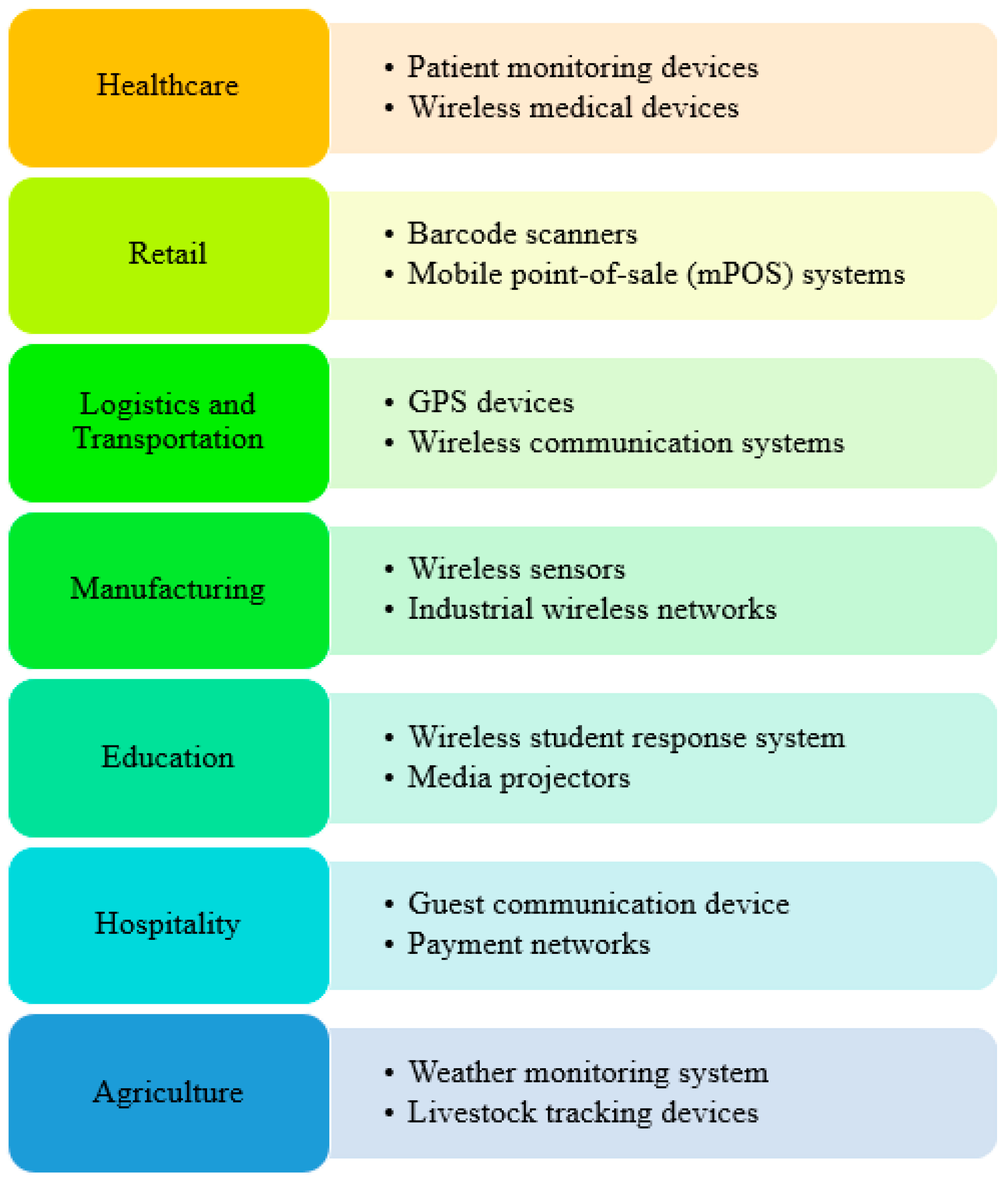
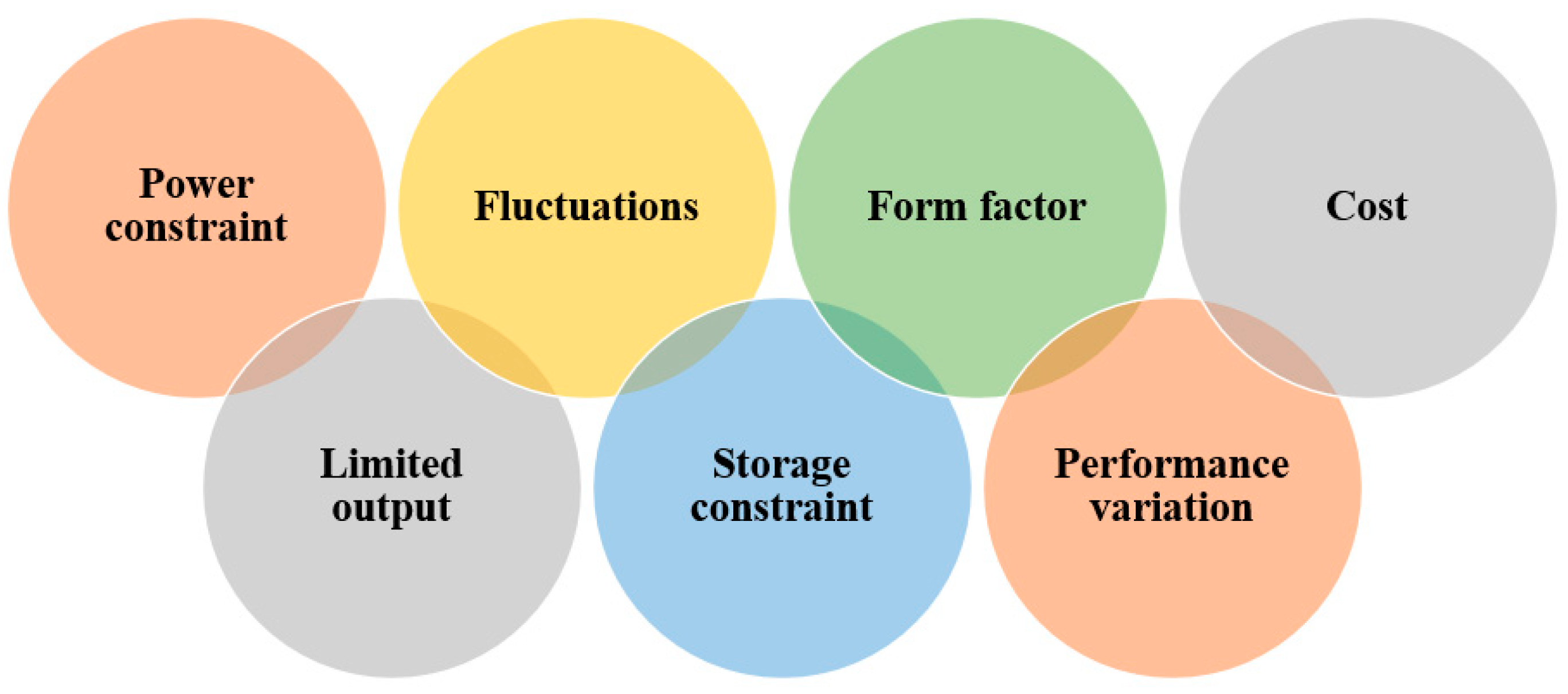
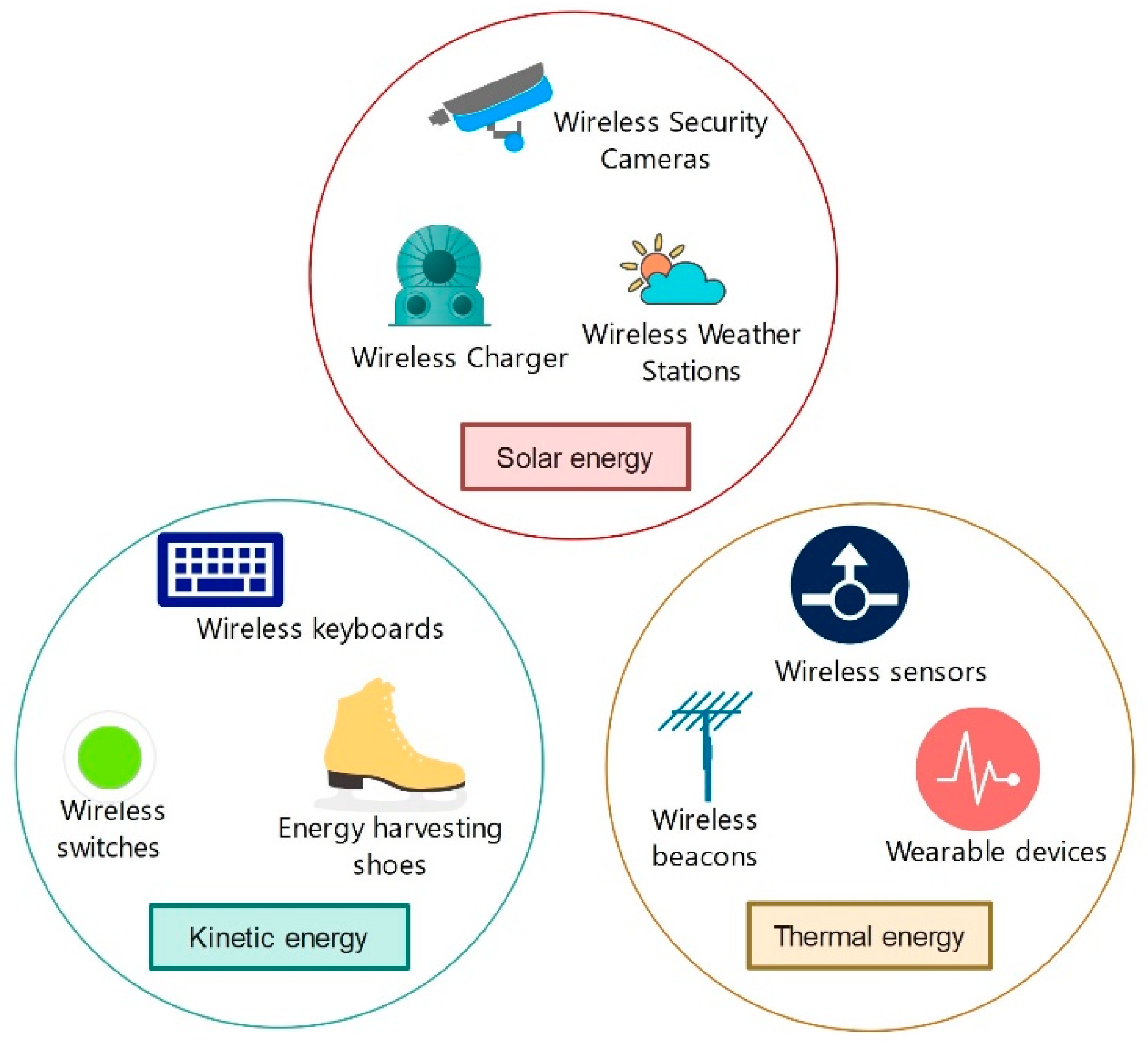
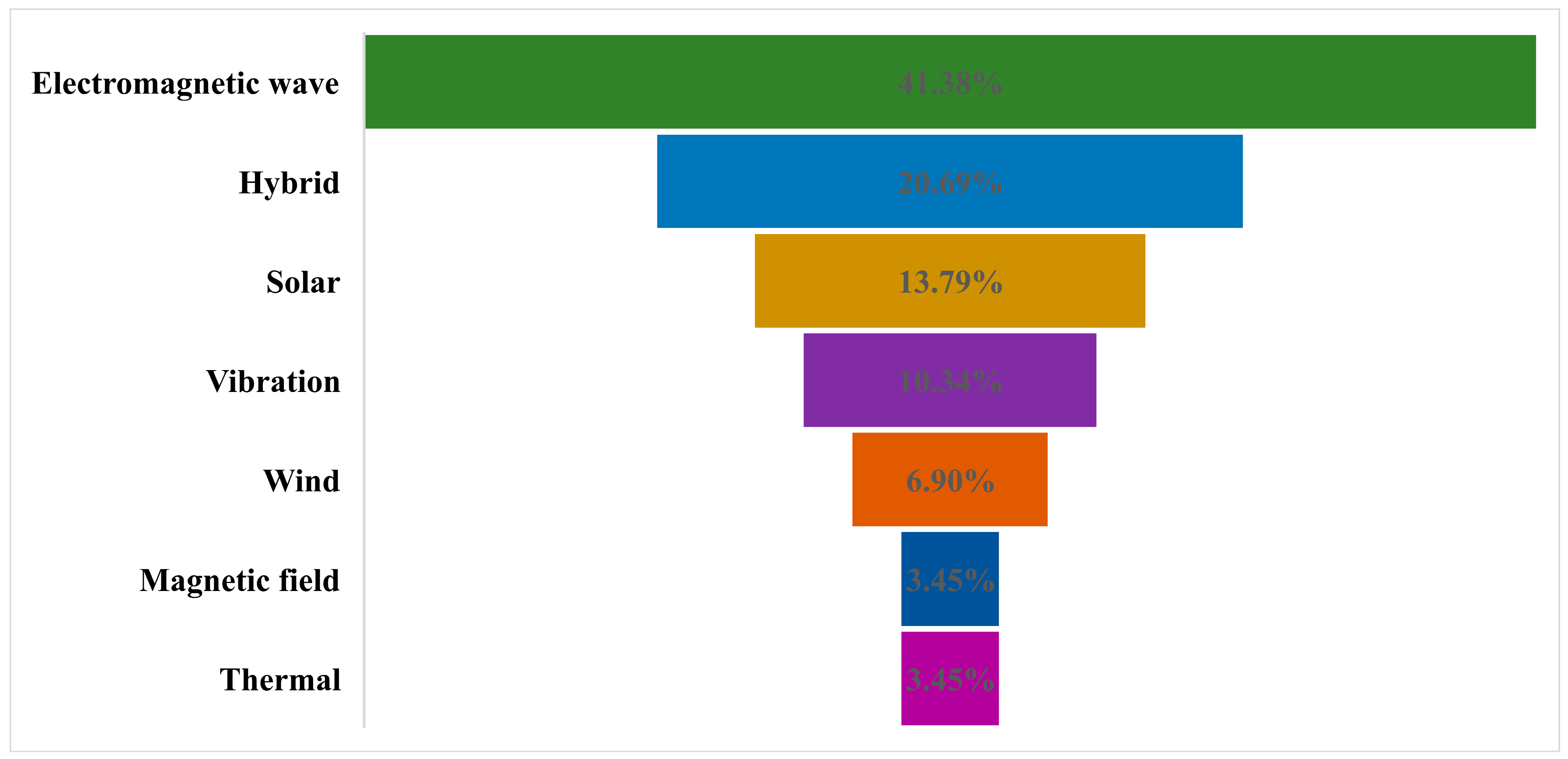
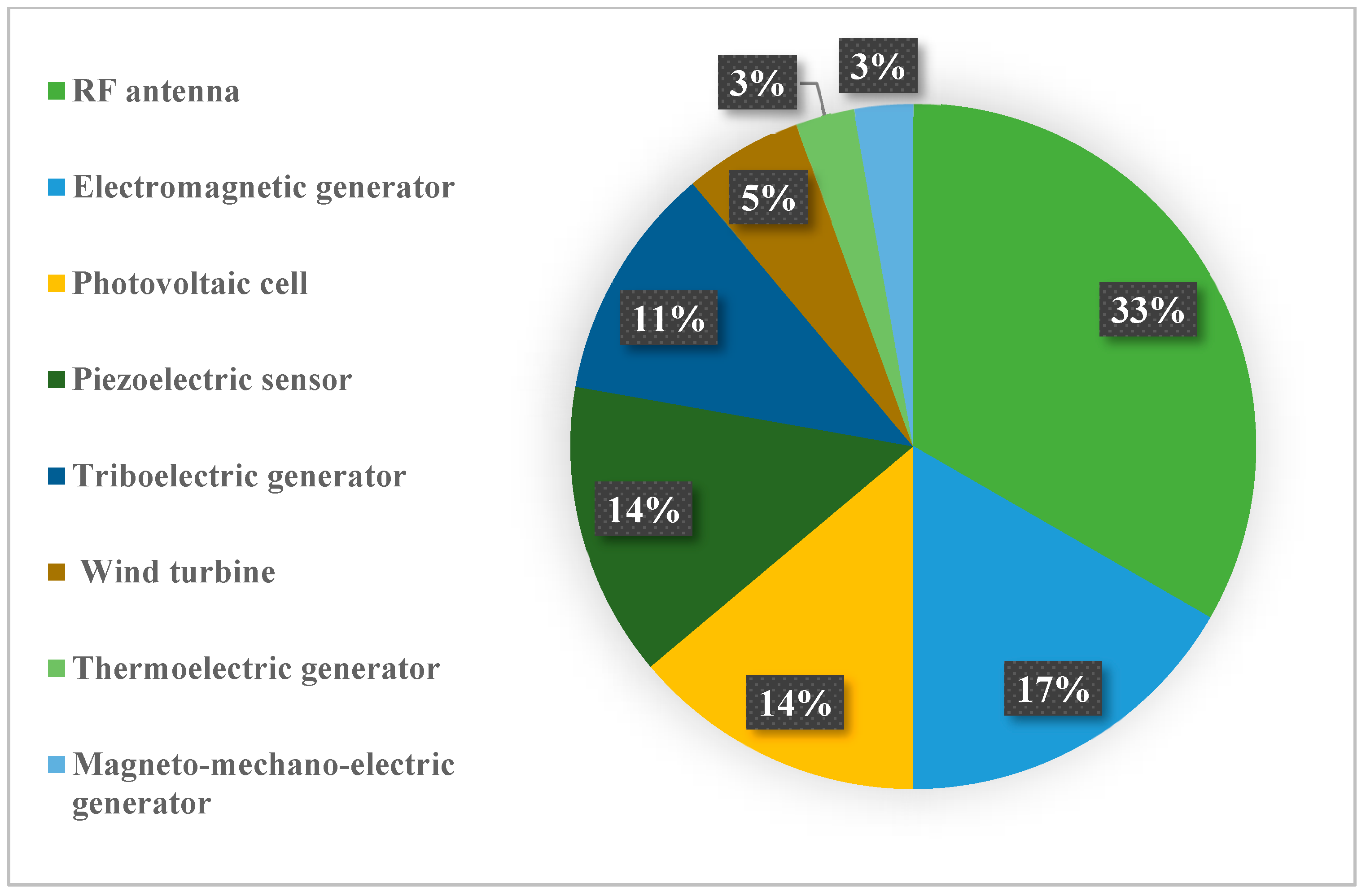
| Functionality Factors | Description |
|---|---|
| Signal strength | Distance between the access points, and interference from other devices and obstacles are some of the issues that affect the signal strength of a wireless device. |
| Interference | Signals from devices that use the same frequency range, such as microwave ovens, cordless mics, and Bluetooth headphones, may interfere with each other and degrade signals’ performance in terms of response speed and disconnection. |
| Frequency band | 2.4 GHz and 5 GHz are the most preferred frequency bands for wireless device operation. Comparatively, 2.4 GHz devices receive interference more easily than 5 GHz devices, but 5 GHz devices can be active only for shorter distances of operation. |
| Channel congestion | Congestion happens in a crowded environment where multiple wireless devices are active. This degrades wireless device performance in terms of response speed and irregular operation. |
| Environmental factors | Weather conditions, building materials, geographical terrain, and reflective surfaces are some of the environmental factors that impact the signal strength and coverage of a wireless system. |
| Power source | Wireless devices such as smartphones and laptops are highly dependent upon the energy availability in the device’s battery source. Battery level also has a small impact over the signal strength of a wireless connection. |
| Merits | Description |
|---|---|
| Hassle-free deployment | Absence of wire allows these devices to be plug-and-play. |
| Non-stop operation | Guarantees continuous operation, as the battery does not need to be replaced. |
| Compactness | Suitable for ultra-low-power industrial circuits. |
| Feasibility | Can be employed in places which are unsafe and hard to reach for maintenance. |
| Power backup | Harvested energy can be stored in a battery source if required. |
| Methodology | Year | Energy Source | Generator Type | Application | Outcome |
|---|---|---|---|---|---|
| Multistage Dickson charge pump circuit [28] | 2023 | Electromagnetic wave | Multi-band RF antenna | IoT/WSN | 78.3% of power conversion efficiency |
| Relay selection method [29] | 2023 | Electromagnetic wave | RF antenna | WBAN | 7.8% of pocket reception rate improvement |
| Power control method [30] | 2022 | Electromagnetic wave | RF antenna | IoT sensor with NodeMCU | Reduced power requirement from 225 mW to 264 µW |
| Adaptive power transfer algorithm [31] | 2022 | Electromagnetic wave | RF antenna | IoT | 49.5 mW outcome of wireless power transfer |
| Distributed resource management algorithm [32] | 2021 | Electromagnetic wave | RF antenna | B5G | Eight times reduced pocket loss compared to greedy algorithm |
| 10-stage cross connected rectifier optimization [33] | 2021 | Electromagnetic wave | RF antenna | IoT | 42.4% of peak end-to-end efficiency |
| Self-designed data and energy integrated network [34] | 2021 | Electromagnetic wave | RF antenna | IoT | Minimizes the sampling data to improve the sleeping time |
| Simultaneous wireless information and power transfer algorithm [35] | 2021 | Electromagnetic wave | RF antenna | 5G/B5G IoT | 7.81 × 10−11 ESA is achieved |
| Intelligent dynamic energy flow control algorithm [36] | 2021 | Electromagnetic wave | RF antenna | WSN | 0.16 μV output per second |
| Rectenna array [37] | 2020 | Electromagnetic wave | RF antenna | IoT | 67% of high energy conversion efficiency over Vivaldi rectenna |
| Hybrid spectrum access mode [38] | 2020 | Electromagnetic wave | RF antenna | Industrial IoT | Achieved larger transmission of data with less power |
| Broadband rectifier and a novel matching network [39] | 2020 | Electromagnetic wave | RF antenna | LTE | 42% efficiency improvement |
| Supercapacitor with hybrid optimization [40] | 2022 | Hybrid solar, wind, and kinetic energy | Photovoltaic cell, wind turbine, and electromagnetic generator | Railway wireless sensors | 2660 mW power generated from 5.5 m/s wind |
| Game theory and perturbed Lyapunov optimization theory [41] | 2021 | Hybrid vibration and kinetic energy | Piezoelectric and electromagnetic transducers | IoT | Better energy efficiency than naïve and greedy offloading |
| Parametric model optimization strategy [42] | 2020 | Hybrid vibration and kinetic energy | Piezoelectric and electromagnetic generators | IoT | 25.45 mW power generated on 0.5G vibration |
| Rational adaptive mechanical design [43] | 2022 | Hybrid wind and kinetic energy | Triboelectric and electromagnetic generators | Wireless environment monitoring | 60 times better output than the traditional model |
| Rotational tapered rollers [44] | 2021 | Hybrid wind and kinetic energy | Triboelectric and electromagnetic generators | IoT | 63.8 mW output |
| Customized boxlike structure [45] | 2020 | Hybrid wind and kinetic energy | Triboelectric and electromagnetic nanogenerators | 5G IoT | 18.66 mW power output at 15 m/s wind speed |
| Magnetic flux intensity control [46] | 2023 | Magnetic field | Magneto-mechano-electric generator | WSN | 5.5 mW power generated from 100e magnetic field |
| Energy per operation optimization [47] | 2020 | Solar | Photovoltaic cell | Wearable IoT | 2.4 times better outcome than manual optimization |
| Boosted by boost converter [48] | 2020 | Solar | Photovoltaic cell | WSN | 5.88 V generated at full sunlight |
| Efficient energy and radio resource management framework [49] | 2020 | Solar | Photovoltaic cell | UAV | Generated 13,000 J for 20 s |
| Prediction-based adaptive duty cycle MAC protocol [50] | 2023 | Solar | Photovoltaic cell | WSN | 76.4% improvement on total energy consumption |
| Smart connector for energy balance [29] | 2023 | Thermal | Two thermoelectric generators | Bluetooth smart grid | 4.9% energy improvement on sleep mode |
| Tapered nonlinear vibration energy harvester with MPPT [51] | 2021 | Vibration | Piezoelectric device | IoT | 2660 μW/cm3g2 of power density is obtained |
| Vibration enhancement mechanism [52] | 2021 | Vibration | Piezoelectric stack | IoT/WSN | 2.622 W power output at 8.5 ms−1 wind speed |
| Cantilever and impact method [53] | 2021 | Vibration | Two piezoelectric devices | Zigbee wireless sensor | 1.5 μW of maximum power output |
| Polymer film thickness alteration [54] | 2022 | Wind | Microwind generator | Wireless sensor | 60 μW of maximum power output |
| In situ carbon dispersion method [55] | 2022 | Wind | High-power triboelectric nanogenerators | Wireless control | 75.2 W/m2 power density |
| Methodology | Future Directions | Challenges |
|---|---|---|
| Electromagnetic wave | Minimizing the size of the RF antenna while maintaining its performance | General properties of the RF antenna material |
| Solar | Intelligent solar panel direction estimations | Space requirement and climate constraint |
| Vibration | Increasing the lifespan of the sensors | Cannot be suitable for several applications |
| Wind | Effienct windflow direction estimation | Climate constraint |
| Magnetic field | Improving the power density observation from the magnetic field | Not suitable for living area |
| Thermal | Increasing the energy conversion efficiency | Requires constant heat source |
Disclaimer/Publisher’s Note: The statements, opinions and data contained in all publications are solely those of the individual author(s) and contributor(s) and not of MDPI and/or the editor(s). MDPI and/or the editor(s) disclaim responsibility for any injury to people or property resulting from any ideas, methods, instructions or products referred to in the content. |
© 2023 by the authors. Licensee MDPI, Basel, Switzerland. This article is an open access article distributed under the terms and conditions of the Creative Commons Attribution (CC BY) license (https://creativecommons.org/licenses/by/4.0/).
Share and Cite
Hezekiah, J.D.K.; Ramya, K.C.; Radhakrishnan, S.B.K.; Kumarasamy, V.M.; Devendran, M.; Ramalingam, A.; Maheswar, R. Review of Next-Generation Wireless Devices with Self-Energy Harvesting for Sustainability Improvement. Energies 2023, 16, 5174. https://doi.org/10.3390/en16135174
Hezekiah JDK, Ramya KC, Radhakrishnan SBK, Kumarasamy VM, Devendran M, Ramalingam A, Maheswar R. Review of Next-Generation Wireless Devices with Self-Energy Harvesting for Sustainability Improvement. Energies. 2023; 16(13):5174. https://doi.org/10.3390/en16135174
Chicago/Turabian StyleHezekiah, James Deva Koresh, Karnam Chandrakumar Ramya, Sathya Bama Krishna Radhakrishnan, Vishnu Murthy Kumarasamy, Malathi Devendran, Avudaiammal Ramalingam, and Rajagopal Maheswar. 2023. "Review of Next-Generation Wireless Devices with Self-Energy Harvesting for Sustainability Improvement" Energies 16, no. 13: 5174. https://doi.org/10.3390/en16135174
APA StyleHezekiah, J. D. K., Ramya, K. C., Radhakrishnan, S. B. K., Kumarasamy, V. M., Devendran, M., Ramalingam, A., & Maheswar, R. (2023). Review of Next-Generation Wireless Devices with Self-Energy Harvesting for Sustainability Improvement. Energies, 16(13), 5174. https://doi.org/10.3390/en16135174







